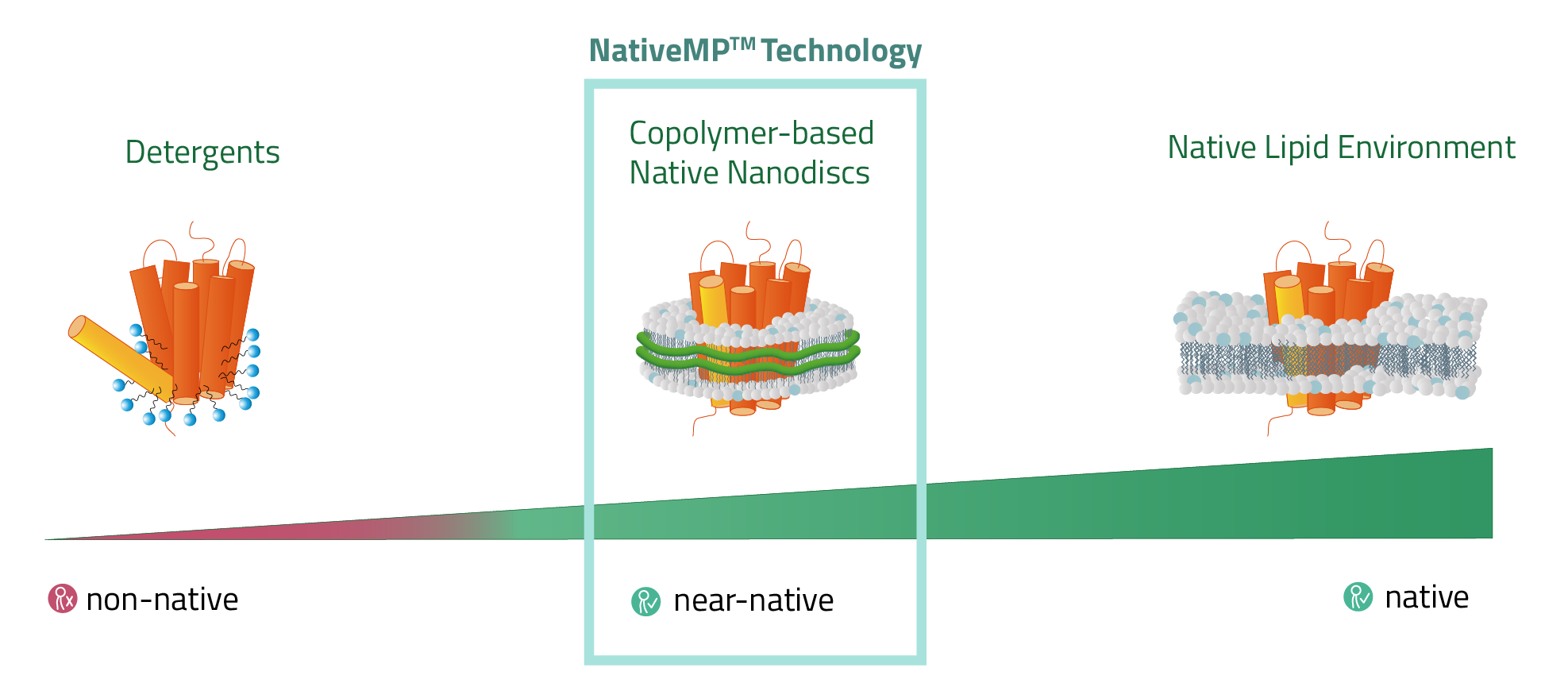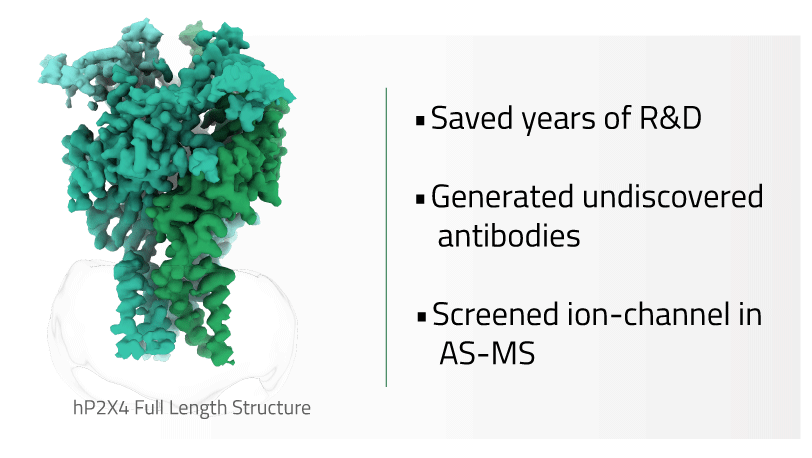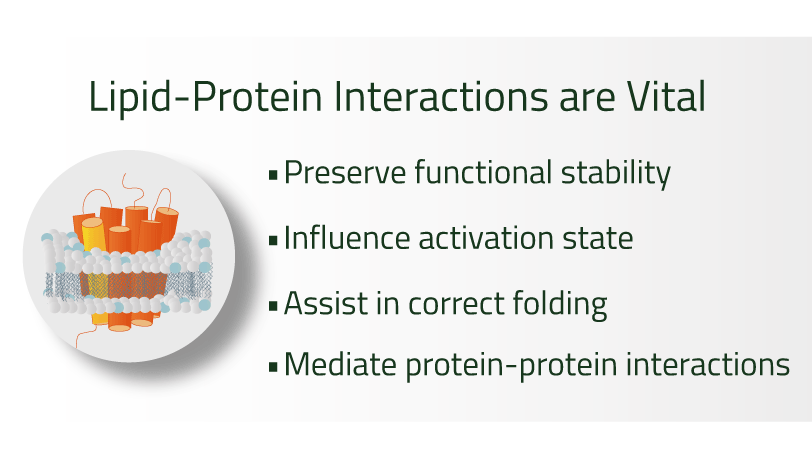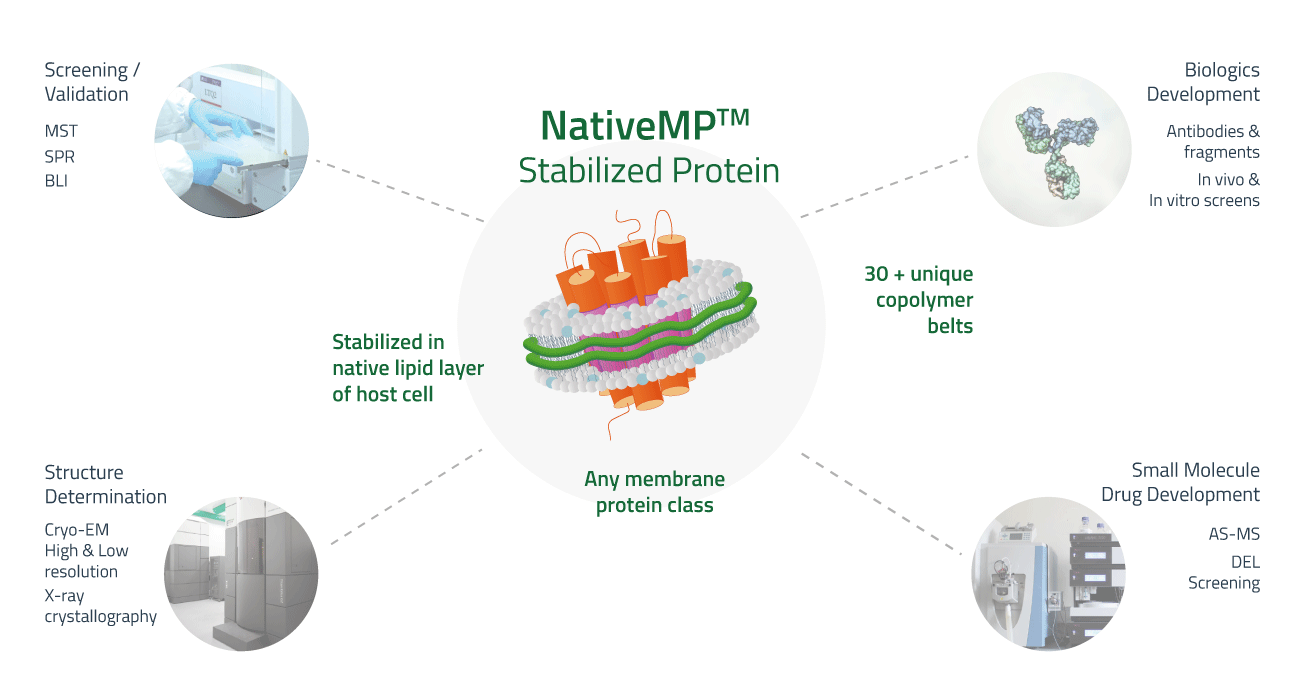NativeMP™ Technology - Solving the Membrane Protein Puzzle
Content:
Introducing the NativeMP™ Technology
We believe in the untapped potential of membrane proteins in drug discovery. Despite 60% of FDA-approved drugs targeting these proteins, less than 2% have been structurally characterized. This gap shows the need for innovation in identifying new drug targets.
To bridge the gap we developed the NativeMP™ technology—a groundbreaking tool that accelerates and enhances the study of membrane proteins.
With the NativeMP™ technology, you can keep membrane proteins stable in their natural lipid environment using advanced copolymers. This ensures that the proteins remain active, allowing you to stabilize potential drug targets in under three months. By dramatically reducing traditional R&D timelines, we empower you to move faster and more efficiently toward groundbreaking discoveries.

| NativeMP™ Technology | Detergents |
|---|---|
| Native lipid-protein encased in copolymer | Detergent micelle |
| Sample preparation at room temperature & up to 37°C | Sample preparation at 4°C |
| Single buffer preparation, required only once in the stabilization process |
Various buffers required at different stabilization steps |
| Unaltered protein, functionalization with biotin or fluorescence directly on the copolymer belt possible |
Protein-alteration needed before labelling |
| Stable for longer periods of time, days to weeks | Short half time life maxima, few days |
| Compatible with phage display & ELISA | Assay interference due to micelles |
Success stories - Case studies
NativeMP™ copolymers solubilize membrane proteins in their natural lipid environment,
allowing us to stabilize KCNA3 in just 2 months—saving years of research time. In addition, stabilizing a membrane protein in a native lipid environment can open new doors. This is how we were able to find 2 previously undiscovered antibodies against the ion channel P2X4 and to stabilize the GLP1R wild type, which had never beean achieved before. And these are just a few examples of our success stories.
Why are membrane proteins so hard to study?
The answer lies in the complexity of lipids. Membrane proteins are notoriously difficult to work with due to their unique amphipathic nature —combining hydrophilic and hydrophobic regions, large size and conformational flexibility. Conventional methods using detergents have had success, but they’re time-consuming and complex. For example, it took over 15 years to solve the structure of KCNA3 (Kv1.3; Selvakumar et al., 2022).
What are conventional techniques missing? The native cell lipid environment.
Over 100,000 studies describe lipid-protein interactions. It has been proven time and time again that the lipid environment is essential for keeping membrane proteins stable and functional. However, detergents often strip away these native lipids, forcing proteins into an artificial surrounding where they struggle to remain stable. But there’s a faster and more accurate way.

Screening is key
Each target is unique, which is why screening is just as important for advanced copolymers as it is for detergents. Our NativeMP™ Platform offers a selection of over 30 copolymer belts, ensuring that you’ll find the right copolymer to meet the specific needs of your target and downstream applications.
Benefits:
- Convenient Process: Copolymers allow for a single step solubilization and stabilization directly from the cell.
- Temperature Stability: Experiments can be carried out at room temperature and up to 37°C.
- Optimized Stabilization: Preserves the native lipid environment of the membrane protein, retaining its functional stability and avoiding disintegration even of large membrane protein complexes.
- Faster Process: NativeMP™ Technology is 100% detergent-free. Forget about preparing different buffers and constantly having to add detergents to your solution. With copolymers, you avoid that and save valuable lab time.
- Application compatibility: Our copolymer technology is compatible with many sensitive downstream applications like immobilization via SPR, ELISA, display technologies and more.

Applications
With the NativeMP™ Technology it's possible to solubilize and stabilize membrane proteins of all sizes and from all membranes of any organism. By stabilizing membrane proteins directly within the native lipid layer of the host cell, the technology allows for more accurate and reliable experimental outcomes. Its compatibility with a variety of applications makes it a valuable asset in drug discovery, biologics development, and structural biology.
- Screening/Validation: NativeMP™ stabilized proteins are a great option for screening assays, as the copolymers do not interfere with most common experimental approaches and allow reliable results by preserving the native state of membrane proteins during interaction studies.
- Biologics Development: The technology facilitates the development of biologics by maintaining the integrity of membrane proteins, which are crucial targets in antibody development and screening assays.
- Small Molecule Drug Development: NativeMP™ copolymers enable the effective stabilization of membrane proteins, which is vital for small molecule screening and drug discovery, ensuring the target protein remains functional and accessible.
- Structure Determination: By preserving membrane proteins in their native environment, the NativeMP™ technology supports high-quality structural studies, allowing for detailed resolution of protein complexes that are critical for understanding their function and for drug design.




